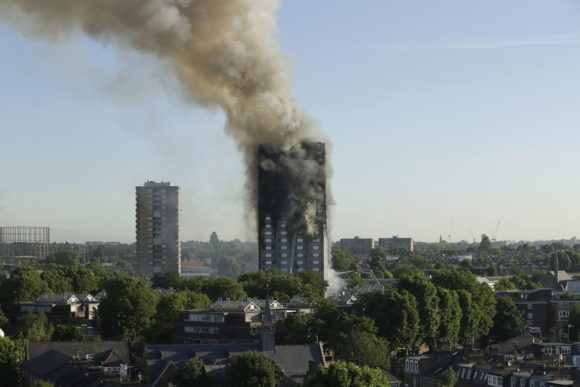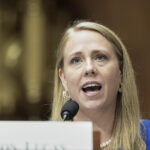A public inquiry into the devastating 2017 London Grenfell Tower blaze concluded on Wednesday that a “culmination of decades of failure” by the government and the construction industry ultimately led to the disaster that killed 72 people.
The report detailed how the government, council, architects, contractors, local council and management firms involved in refitting the exterior with flammable cladding – exterior panels designed to improve appearance and add insulation – bear much of the blame for what happened seven years ago.
THE GOVERNMENT
The report said the government, which at the time was led by former Conservative Prime Minister Theresa May, had “many opportunities” over the years to identify the risks posed by the use of combustible cladding and insulation in high-rise buildings, had ignored numerous warnings and failed to act.
UK Grenfell Tower Fire Inquiry Blames All Deaths on Incompetence and Greed
In 2001, the government failed to pay due regard to the “striking results” of a large-scale test involving flammable cladding and failed to communicate the dangers to industry.
Following a 2009 blaze at Lakanal House, another high-rise block in south London, the government’s thinking was so focused on deregulation that it ignored or delayed matters affecting the safety of life, the report said.
Inquiry chair Martin Moore-Bick said previous governments and others failed to amend guidance on the construction of external walls: “That is where the seeds of the disaster were sown.”
ROYAL BOROUGH OF KENSINGTON AND CHELSEA (RBKC)
The wealthy Royal Borough of Kensington and Chelsea (RBKC), the local authority, failed to scrutinize the design or choice of materials and ensure that on completion of the refurbishment work the building complied with building requirements.
“It [RBKC] therefore bears considerable responsibility for the dangerous conditions of the building immediately on the completion of the work,” the report said.
The response by RBKC and the central government to the Grenfell fire and the needs of victims was “muddled, slow, indecisive and piecemeal,” sometimes demonstrating a “marked lack of respect for human decency and dignity.”
Many victims were left feeling abandoned by authorities and utterly helpless, with their only support from volunteers.
Elizabeth Campbell, leader of the Kensington and Chelsea Council, apologized “unreservedly” for “our failure to listen to residents and to protect them.”
“We fully accept the findings, which are a withering critique of a system broken from top to bottom. It is crystal clear – profits were put before people, clear warning signs were ignored, and Grenfell was wholly avoidable, with failure at every single level,” Campbell said in a statement.
TENANT MANAGEMENT ORGANISATION
The Tenant Management Organisation (TMO), the public body exercising control over the building, and RBKC were jointly responsible for the management of fire safety at Grenfell Tower.
The report said TMO wanted to reduce the cost of the tower’s refurbishment by using ACM panels and must also bear responsibility for the disaster. It failed to take sufficient care in its choice of architect and on matters of fire safety.
THE FIRMS
A significant reason why Grenfell Tower came to be clad in combustible insulation and aluminum composite materials (ACM) panels was the “systematic dishonesty” by an array of companies, the report said, adding some manipulated testing processes, misrepresented tested data and mislead the market.
The French subsidiary of the American company Arconic manufactured and sold the ACM cladding, and from 2005 until after the fire “deliberately concealed from the market the true extent of the danger” of such cladding.
In response to the report, Arconic said its product was safe and legal, and that it regularly tested its materials. It said it did not conceal information or mislead any certification body, customer or the public.
Arconic said its subsidiary cooperated fully with the work of the inquiry.
Celotex and Kingspan, which made the foam insulation, are also to blame, the report said.
In a bid to break into the insulation market for high-rise buildings, Celotex “embarked on a dishonest scheme to mislead its customers and the wider market.”
Kingspan sold insulation that was not suitable for external use in high-rise buildings.
Kingspan said in statement that the type of insulation was immaterial and the principal reason for the spread of the fire was the ACM cladding, which was not made by Kingspan.
“Kingspan has long acknowledged the wholly unacceptable historical failings that occurred in part of our UK insulation business. These were in no way reflective of how we conduct ourselves as a group, then or now,” it said.
ARCHITECTS AND OTHER CONTRACTORS
None of those involved in the design of the external walls or the choice of materials, such as architectural firm Studio E, “acted in accordance with the standards of a reasonably competent person in their position,” the report said.
Studio E, responsible for the design of the external walls and the choice of materials, had wanted to use zinc rainscreen panels but the ACM version was chosen largely on cost grounds.
Construction contractor Rydon was able to offer a substantial saving due its relationship with the cladding sub-contractor Harley. The inquiry said all three took a casual approach to contractual relations.
Harley, the report said, did not concern itself sufficiently with fire safety at any stage of the refurbishment.
Studio E demonstrated a “cavalier attitude” to fire safety regulations and Rydon and Harley relied on their previous experience rather than on any technical analysis or expertise.
Fire safety inspectors Exova were instructed by Studio E, on behalf of the TMO, to prepare a fire safety strategy for Grenfell but although a draft was prepared, it was never completed.
LONDON FIRE BRIGADE
After the fatal fire at Lakanal House, the London Fire Brigade (LFB) should have been “alerted” to the “shortcomings of its own ability to fight fires in high-rise buildings,” the report said. LFB also should have made better use of the knowledge it gained.
The LFB, the report said, was ill prepared to deal with Grenfell for several reasons, such as a “chronic lack of effective management and leadership” and the “unfounded assumption” that pre-existing building regulations were sufficient.
OTHER BODIES NAMED IN REPORT
The Building Research Establishment played an important role in enabling Celotex and Kingspan to market their insulation products for use in the external walls of high-rise buildings, while the National House Building Council failed to ensure its building control function remained “free of commercial pressures.”
(Reporting by Catarina Demony and Michael Holden; editing by Elizabeth Piper and Alexandra Hudson)
Photograph: Smoke rises from a high-rise apartment building on fire in London, on Wednesday, June 14, 2017. (AP Photo/Matt Dunham)
Was this article valuable?
Here are more articles you may enjoy.



 UPS Ripped Off Seasonal Workers With Unfair Pay Practices, Lawsuit Alleges
UPS Ripped Off Seasonal Workers With Unfair Pay Practices, Lawsuit Alleges  Viewpoint: Artificial Intelligence Is Rewriting the Rules for Commercial Lines
Viewpoint: Artificial Intelligence Is Rewriting the Rules for Commercial Lines  Head of EEOC Urges White Men to Report Discrimination
Head of EEOC Urges White Men to Report Discrimination  Underwriter, Actuary Fears of AI Drop; Work Needed on Collaboration
Underwriter, Actuary Fears of AI Drop; Work Needed on Collaboration 

